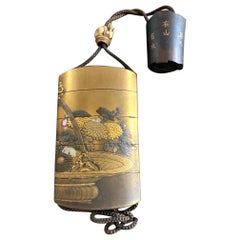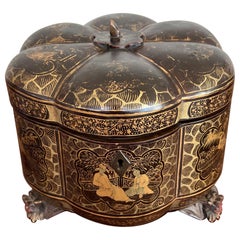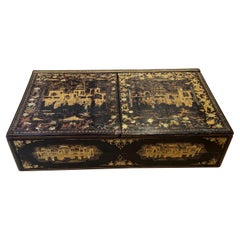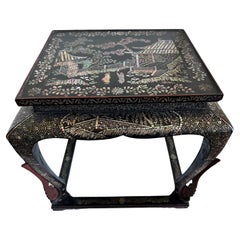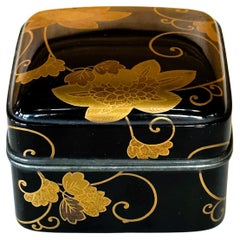Georgia - Lacquer
61
1
to
3
62
420
145
62
62
62
1
1
10
36
15
1
11
1
1
3
1
59
43
7
5
4
60
58
53
4
2
Item Ships From: Georgia
Antique Japanese Inro by Shigehide Edo Period
Located in Atlanta, GA
This exquisite four-case lacquered inro was dated to the latter part of 18th century to early 19th century (Edo period) and made by Shigehide. The opposite sides of the inro together features a lavish flower arrangement in a bamboo basket (ikebana). The detailed craftmanship was a true pleasure to behold. Mostly Takamaki-e (high relief) were used to texturize the delicate petals of the chrysanthemums, on which different shades of gold were used to create contrast. Raden (mother of pearl) shells were also used to highlight some leaves, rendering the piece an interesting balance of color and material. The interior was completed in a mottled gold finish. It was signed Shigehide on the bottom with a Kao. There is a small carved rabbit ojime bead...
Category
Late 18th Century Japanese Japonisme Antique Georgia - Lacquer
Materials
Wood, Lacquer
19th Century, Chinese Export Gilt Black Lacquer Melon Form Tea Caddy Box
Located in Atlanta, GA
Chinese, 19th century.
Chinese lacquer and gilt decorated melon form tea caddy chest or box. The piece is heavily decorated with chinoiserie windows and supported by three giltwood ...
Category
Mid-19th Century Chinese Chinese Export Antique Georgia - Lacquer
Materials
Giltwood, Lacquer
Antique Japanese Lacquer and Inlay Kang Table from Ryukyu Island
Located in Atlanta, GA
A small low table with lacquer and intricate mother-of-pearl inlay design from Ryukyu Islands kingdom circa 17-18th century. Ryukyuan kingdom was used to be an independent island cou...
Category
18th Century Japanese Edo Antique Georgia - Lacquer
Materials
Mother-of-Pearl, Lacquer
Exceptional Chinese Export Gilt Black Lacquer Chinoiserie Decorated Lap Desk
Located in Atlanta, GA
Chinese export, circa 1820.
An exceptional quality and rare form. Featuring figural landscape decorations in gilt to the main black lacquer doors, which open to reveal 13 separated c...
Category
Early 19th Century Chinese Chinese Export Antique Georgia - Lacquer
Materials
Giltwood, Lacquer
Antique Japanese Lacquer and Inlay Table from Ryukyu Islands
Located in Atlanta, GA
A small square-form table with lacquer and intricate mother-of-pearl inlay design from Ryukyu Islands kingdom circa 17-18th century. Ryukyuan kingdom was used to be an independent is...
Category
18th Century Japanese Edo Antique Georgia - Lacquer
Materials
Mother-of-Pearl, Lacquer
Antique Japanese Lacquered Incense Box Kobako in Kodaiji Style
Located in Atlanta, GA
An antique lacquered small box that was likely used to contain incense powder (it is called Kobako in Japanese), circa early to mid-19th century of the Edo...
Category
19th Century Japanese Edo Antique Georgia - Lacquer
Materials
Wood, Lacquer
Japanese Maki-e Lacquer Tray Box with Cutout Design
Located in Atlanta, GA
A Japanese lacquer box with lid and an inner tray decorated with Maki-e on a dense nashiji background. The fine box was likely made circa 1920-30s during the Tashio period and likely...
Category
1920s Japanese Taisho Vintage Georgia - Lacquer
Materials
Wood, Lacquer
Red and Gold Lacquer Portable Tea Bucket and Cover Ryukyu Kingdom Okinawa
Located in Atlanta, GA
A rare and complete set of wood bucket with cinnabar lacquer and gold paint housing a pewter tea pot with a fabric pouch from Ryukyu Kingdom, Second Shō dynasty, circa 19th century. Located in nowadays Okinawa Prefecture, Japan. Ryukyu kingdom (1429 to 1879) was a tributary state of imperial Ming...
Category
19th Century Japanese Edo Antique Georgia - Lacquer
Materials
Pewter
19th-C. English Black Lacquer And Gilt Chinoiserie Papier-mâché Wall Art / Tray
Located in Kennesaw, GA
This is a late 19th century English regency black lacquer and gilt chinoiserie papier-mâché tray. The Japanning depicts pastoral and coastal scenes. It is in very good condition,
Category
Late 19th Century English Regency Antique Georgia - Lacquer
Materials
Lacquer
Antique Japanese Traveling Altar Aizen Myoo or Ragaraja King of Wisdom Funno Son
Located in Atlanta, GA
An antique Japanese traveling altar of Aizen Myoo or Ragaraja. I believe the object to be older than the 'early 20th century' guess I offered, but I'm ...
Category
Early 20th Century Japanese Georgia - Lacquer
Materials
Giltwood, Lacquer, Wood
Japanese Lacquered Maki-E Natsume in Kodaiji Style
Located in Atlanta, GA
A Japanese lacquered tea caddy (known as Natsume) with fine Maki-e decoration circa 18-19th century Edo to Meiji period. The large-sized nat...
Category
19th Century Japanese Meiji Antique Georgia - Lacquer
Materials
Wood, Lacquer
Japanese Lacquered Maki-e Fubako Edo Period
Located in Atlanta, GA
A Japanese lacquered wood fubako (a box used to store document or small scroll painting), circa second half of 19th century late Edo period. The rectangular box features an unusually deep lipped lid with slightly rounded corners, a conforming lower box that is almost entirely covered by the lid which has two bronze medallion rings with tasseled...
Category
19th Century Japanese Edo Antique Georgia - Lacquer
Materials
Wood, Lacquer
Japanese Lacquered Sake Drinking Set Meiji Period
Located in Atlanta, GA
A Japanese lacquered Sake Drinking set circa late 19th century (end of Meiji period), The assemble consists of a red lacquer stand open frame support and a lid that encloses a storage space with black lacquered interior. The lid features a and a cup holder in the center and four heart shape cutouts on the corners. There are three maki-e decorated sake cups with gradual sizes. The cups showcase on the red background elaborate gold hiramaki-e paintings...
Category
Late 19th Century Japanese Meiji Antique Georgia - Lacquer
Materials
Wood, Lacquer
Japanese Lacquered Maki-E Fubako in Kodaiji Style
Located in Atlanta, GA
A rare Japanese lacquered wood fubako decorated in Kodaiji maki-e style circa early 17th century the beginning of the Edo period, possibly early toward the end of the Azuchi-Momoyama period. The rectangular, long and slim box features a deep lipped lid with slightly rounded corners, a conforming lower box with two bronze medallion rings with tasseled...
Category
Early 17th Century Japanese Edo Antique Georgia - Lacquer
Materials
Wood, Lacquer
Fine Miniature Japanese Kodansu with Lacquer Inlays
Located in Atlanta, GA
A fine Japanese miniature kodansu constructed from Kaki wood (Persimmon) circa 19th century, late Meiji period. With its expressive exotic wood grains and exposed tenon construction,...
Category
Late 19th Century Japanese Meiji Antique Georgia - Lacquer
Materials
Wood
Japanese Lacquered Gold Maki-E Naga Fubako Meiji Period
Located in Atlanta, GA
A Japanese lacquered wood Naga Fubako (a long box used to store document or large scroll painting), circa 19th century Meiji period. The rectangular box features an unusually deep lipped lid with slightly rounded corners, a conforming lower box with bronze medallion rings with tasseled...
Category
19th Century Japanese Meiji Antique Georgia - Lacquer
Materials
Wood, Lacquer
Japanese Maki-e Lacquer Stack Box Jubako
Located in Atlanta, GA
An antique jubako (stack boxes) with five tiers in an elongated octagon shape circa 19th century (end of Edo or beginning of Meiji period). jubako was traditionally used to store and...
Category
19th Century Japanese Japonisme Antique Georgia - Lacquer
Materials
Wood, Lacquer
Pair of Large Antique Japanese Hokai Lacquer Boxes
Located in Atlanta, GA
A pair of Japanese lacquered lidded Hokai boxes with chased brass hardware and original ropes. Hokai boxes are traditionally used in Japan as the containers ...
Category
Early 20th Century Japanese Japonisme Georgia - Lacquer
Materials
Wood, Lacquer
Japanese Lacquer Box with Fine Maki-e Decoration Meiji Period
Located in Atlanta, GA
A lacquered wood box with lid from Japan circa 19th century Meiji Period. The finely decorated box was used to store paper slips and small documents on the desk. It is overall finished with black lacquer (kuro) with sparse Mura-Nashiji effect outside and on the top surface of the lid, there are three Komainu, (sometimes known as Shishi or Japanese lions) frolicking and forming a circle in lively motion. Komainu are auspicious animals in Japanese cultures in both Shinto and Buddhism tradition. Originally from China, these animals symbolizes guardians to ward off evil spirits. Hiramaki-e was used in combination with carving and combing to render the lions with various surface textures. A gilt border with an slight angle was given to the lid and even the thin band is decorated with miniature floral scrolls. The interior of the box was finished in a dense nashiji. Underneath the lid, a cluster of peonies open lavishly by two gentle mounts. Takamaki-e (high relief) in both gold and silver were...
Category
Late 19th Century Japanese Japonisme Antique Georgia - Lacquer
Materials
Wood, Lacquer
Japanese Lacquer Maki-E Scroll Box Fubako by Kansonsai Edo Period
Located in Atlanta, GA
A Japanese lacquered wood fubako (a box to store document or small scroll painting) circa late 18th century of Edo period. The rectangular box features a deep lid with rounded corners and recessed mid-edge and a lower box with two bronze medallion rings and tasseled silk ties. The surface of the fubako was elaborately decorated with hiramaki-e and a low takamaki-e on a mottled Mura-nashiji background. The motifs on the lid depict branches of Japanese pine with finely rendered needles on the lower part; on the upper part, it showcases fruited persimmon branches. Two different shades of gold fundame were used to contrast the design and augmented by scattered gold kirigane to highlight some of the leaves. The design continues and cascades down to all sides of the lid as well as the walls of the box. The two bronze medallions appear original to the box and the silk ties show significant fading from the age. This Fine fubako is signed on the lower wall "Kanshosai" in Kanji with a kao mark. All the trims were finished in gold fundame and the interiors a dense nashiji in gold.
Kanshosai is the mark of the distinguished lacquer artist Lizuka Toyo I who also signed his work "Toyosai". He was active in the second half of the 18th century during Edo period, employed by Hachisuka Shigeyoshi (1738-1801), daimyo of Awa on Shikoku Island. Although most survived work bearing his marks are inros, he was also known to decorated trays and other larger objects...
Category
Late 18th Century Japanese Edo Antique Georgia - Lacquer
Materials
Wood, Lacquer
Japanese Lacquer Maki-E Tiered Suzuribako and Ryoshibako
Located in Atlanta, GA
A Japanese roiro lacquer scholar combo box with an upper tier of inkstone box (Suzuribako) and a lower document box (Ryoshibako) circa 1910-30s (end of Meiji to Showa period). The high glossy box was beautifully decorated with an image of the famously eccentric Buddhist monks Hanshan and Shide (known in Japan as Kanzan and Jittoku). Often as a pair, they have been a popular motif in Japanese Zen painting...
Category
1920s Japanese Meiji Vintage Georgia - Lacquer
Materials
Stone, Metal
Japanese Lacquer Maki-e Plate of Takasago Story
Located in Atlanta, GA
A large circular plate with a short stem base in Vermillion lacquer color from Late Meiji Period circa end of 19th century to early 20th century. ...
Category
19th Century Japanese Meiji Antique Georgia - Lacquer
Materials
Lacquer
Japanese Lacquer Maki-e Plate of Masked Dancer
Located in Atlanta, GA
A large circular plate with a short stem base in Vermillion lacquer color from Late Meiji Period circa end of 19th century to early 20th century. ...
Category
19th Century Japanese Meiji Antique Georgia - Lacquer
Materials
Lacquer
Japanese Lacquered Samurai Jingasa Hat Edo Period
Located in Atlanta, GA
A bespoken Japanese historical hat known as Jinggasa (militant hat) that was worn by samurai in Edo period (1603-1868) circa 18-19th century. There were several subtypes of Jingasa a...
Category
19th Century Japanese Japonisme Antique Georgia - Lacquer
Materials
Wood, Lacquer
Japanese Rinpa Style Lacquer Ink Stone Box Suzuribako
Located in Atlanta, GA
A Japanese writing box with ink stone (known as Suzuribako) with exquisite maki-e decoration circa late Meiji to early Taisho period (1890s-1930s)...
Category
Early 20th Century Japanese Japonisme Georgia - Lacquer
Materials
Wood, Lacquer
Japanese Antique Lacquer Maki-E Miniature Hasami-Bako with Copper Mounts
Located in Atlanta, GA
A Japanese lacquered box with lid in the shape of a miniature Hasami-Bako (traveling chest) circa late 18 to early 19th century of the Edo period. The black box is decorated with fin...
Category
Early 19th Century Japanese Japonisme Antique Georgia - Lacquer
Materials
Copper
Antique Japanese Lacquered Incense Box Kobako Ex-Christie's
Located in Atlanta, GA
An old Japanese lacquered small box likely used to contain incense powder called Kobako, circa Momoyama to early Edo period (16-17th century). The rectangular form box with a fitted ...
Category
17th Century Japanese Japonisme Antique Georgia - Lacquer
Materials
Lead
Japanese Meiji Han Koto with Maki-e Lacquer Decoration
Located in Atlanta, GA
A rare Japanese Koto made from carved Paulownia wood and lavishly decorated with lacquer Maki-e circa late 19th century of Meiji Period (1868-1912). The ...
Category
Late 19th Century Japanese Japonisme Antique Georgia - Lacquer
Materials
Wood
Pair of Large Japanese Carved Wood Temple Candleholders Edo Period
Located in Atlanta, GA
A tall pair of Japanese carved wood candle holders circa early 19th century (late Edo Period). The pair is carved in the typical form with a block base in the shape of stylized chrysanthemums and long fluted stem with changes in diameter that supports a grooved holder fitted with metal pricket. These types of oversized candle holders were traditionally used in Buddhist temples or Samurai's resident where they were placed on the altar table for worshiping. What is extraordinary of these candle stickers is that they feature a wonderfully conserved surface with lacquered gold leaf. The sparkling gold on the well weathered surface is visually striking. The professional conservation was performed in 2007 and as a result, the pieces display a wonderful aged Wabi-Sabi patina.
The piece retains an original invoice from Far Eastern Antiques...
Category
Early 19th Century Japanese Japonisme Antique Georgia - Lacquer
Materials
Gold Leaf
Exquisite Japanese Lacquer Maki-e Suzuribako by Koma Kyūhaku Edo Period
Located in Atlanta, GA
One of the finest Japanese Maki-e Suzuribakos (ink box) we have on offer, the roiro color box showcases an ambient nocturnal scene in which two shakudo inlaid crows perched on the handrails of a bridge (possible the Uji Bridge...
Category
Early 19th Century Japanese Japonisme Antique Georgia - Lacquer
Materials
Stone, Metal
Japanese Lacquer Maki-e Sake Ewer Meiji Period
Located in Atlanta, GA
A Japanese lacquered wood sake ewer with maki-e design, circa late 19th century, Meiji period. The nicely decorated lacquerware is of a Classic sake ewer for...
Category
1890s Japanese Japonisme Antique Georgia - Lacquer
Materials
Lacquer
Pair of Large Antique Japanese Hokai Lacquer Boxes
Located in Atlanta, GA
A pair of Japanese lacquer lidded Hokai boxes with chased brass hardware and original ropes. Hokai boxes are traditionally used in Japan to store and carry s...
Category
Early 20th Century Japanese Japonisme Georgia - Lacquer
Materials
Wood, Lacquer
Rare Japanese Sumi-E Lacquer Inro Yamada Jokasai Edo Period
Located in Atlanta, GA
A three-case lacquered Inro by Yamada Family circa 18th-19th century Edo period. The inro with slight rounded form is of Kano style and vividly depicts a dragon slithering among the ink clouds on a gold background. Sumi-e togidashi (ink togidashi) technique, in combination with Hiramaki-e, were employed to create the dreamy ambience of this piece. The dragon has a painterly appearance inspired by Chinese ink painting that was often seen on the Japanese folding screens. The back of the Inro was sparsely decorated with the shifting patterns of the darkening clouds with an emphasis on the space intentionally left empty. Jokasai was signed to the base. On the front of the inro there is another miniature signature Hakugyoku Hogen, which is one of names used by Kano Michinobu (1730-1790). The dragon is evidently one of his designs (see reference below).
Established by a member of Yamada family in the 17th century, the clan was one of the most prominent lacquer artisanal family for the next 200 years until the end of Edo period in the 19th century. Most members signed their work simply with Jokasai making the identification of the individual artists somewhat impossible. The current Inro on offer, compared to many other pieces by Jokasai, has an uncommon Kano style done in Sumi-e togidashi.
Another unusual feature of this piece is that the interiors of the inro was decorated with an interesting gold mosaic inlays (kirigane) on a dark lacquer background, giving it a jewel like quality.
For another Inro by Jokasai of a similar style using Sumi-e togidashi but depicts a tiger, see Wrangham collection, no.353, which was offered for sale as lot 256 in Bonham's London Auction: The Edward Wrangham Collection of Japanese Art Part I. 9 Nov 2010.
For an ink scroll...
Category
18th Century Japanese Japonisme Antique Georgia - Lacquer
Materials
Wood, Lacquer
Japanese Maki-e Lacquer Portable Sagejubako Theme of Three Winter Friends
Located in Atlanta, GA
Sagejubako is a portable lunch or picnic set that became popular in the early Edo period when an additional meal was added between breakfast and dinner. It normally consists of a han...
Category
19th Century Japanese Japonisme Antique Georgia - Lacquer
Materials
Lacquer
Japanese Maki-e Lacquerware Portable Picnic Set Sagejubako
Located in Atlanta, GA
Sagejubako is a portable picnic set that became popular in the early Edo period when an additional meal was added between breakfast and dinner. It normally consists of a carry case w...
Category
19th Century Japanese Japonisme Antique Georgia - Lacquer
Materials
Lacquer
Chinese Red Lacquer and Gold Detailing Dome Top Trunk on Feet, 20th Century
Located in Savannah, GA
Chinese red lacquer and gold detailing dome top trunk on feet, 20th century.
Category
20th Century Chinese Georgia - Lacquer
Materials
Lacquer
Antique Japanese Lacquer and Inlay Box from Ryukyu Island
Located in Atlanta, GA
A lacquer presentation box with mother-of-pearl inlays from Japanese Ryukyu Islands circa 17-18th century. The lidded box in rectangular form with rounded corner is a classic example...
Category
18th Century Japanese Japonisme Antique Georgia - Lacquer
Materials
Mother-of-Pearl, Lacquer
Vintage Korean Lacquer Box with Inner Tray and MOP inlays
Located in Atlanta, GA
A lovely vintage Korean lacquer box in bright red and decorated with mother-of-pearl inlays circa 1970-80s. The square form box features an auspicio...
Category
Late 20th Century Korean Arts and Crafts Georgia - Lacquer
Materials
Mother-of-Pearl, Lacquer
Fine Japanese Lacquered Inro with Inlays by Kajikawa
Located in Atlanta, GA
A Japanese four-case lacquer inro by a member of Kajikawa family circa 19th century (late Edo to early Meiji period). It depicts a nocturnal scenery of a meandering stream surrounded by bush clovers, where a full moon is reflected on the water. It was masterfully decorated in gold and silver maki-e using a combination of techniques including takamakie, togidashi and kirigane as well as aogai (abalone shell) inlays. The stream was set between the slightly elevated banks, adding to this piece a already strong three-dimensional composition. The interior was decorated in gold nashiji. It was signed on the bottom "Kajikawa Zou" (made by Kajikawa and a pot seal centered with "Ei" in Kanji. In one of the compartment, there is a katakana mark, appears to be a name, possibly the owner.
Kajikawa clan was one of the most famous lacquer artisanal family established in the 17th century. Many well known members over the generations produced lacquer art in a wide range of formats, but two third were signed only with the family name such as this one. It is therefore not possible to pinpoint the exact author of this piece.
Provenance: This inro was purchased as lot 349 in Christie's New York sale Japanese...
Category
19th Century Japanese Japonisme Antique Georgia - Lacquer
Materials
Wood, Lacquer, Shell
Japanese Lacquer Tray with Maki-e and Inlay Hara Yoyusai Edo Period
Located in Atlanta, GA
A lovely Japanese lacquer rectangular lacquer tray with a slightly scalloped corner and four L shape supporting feet by one of the most celebrated lacquer artist active in Edo period Hara Yoyusai (1772-1845). Yoyusai lived in Edo (Tokyo) and worked under the patronage of Lord Matsudaira. He operated a large workshop and had a very prolific output of lacquer objects. Most survived pieces being inro...
Category
19th Century Japanese Japonisme Antique Georgia - Lacquer
Materials
Wood, Lacquer
Four Japanese Lacquered Sake Cups Meiji Period
Located in Atlanta, GA
An assemble of four lacquerware sake cups from Meiji period Japan circa late 19th century. The shadow cups on an elevated stem were used by the nobles during ...
Category
Late 19th Century Japanese Meiji Antique Georgia - Lacquer
Materials
Wood, Lacquer
Japanese Rinpa Style Lacquer Box Meiji Period
Located in Atlanta, GA
A black lacquer tebako (hand box) with maki-e decoration and silver trim, circa late 19th century, Meiji period. The surface of the lid features a Rinpa style maki-e paint depicting ...
Category
1890s Japanese Japonisme Antique Georgia - Lacquer
Materials
Wood, Lacquer
Japanese Inro by Koma Koryu Edo Period
Located in Atlanta, GA
A four-case lacquered inro by Koma Koryu circa 19th century late Edo period. The inro features a pair of Chinese mandarin duck resting under a bundle of blooming irises on the pond. ...
Category
19th Century Japanese Japonisme Antique Georgia - Lacquer
Materials
Wood, Lacquer
Set of Four Japanese Maki-e Lacquered Pedestal Dishes
Located in Atlanta, GA
A set of four Japanese shallow footed bowls or dishes in red lacquer with predominantly gold Makie design circa 1920s-1930s Taisho period. Each was decorated with hiramakie painting of different motifs, mostly gold, black and pewter color. One with a temple drum...
Category
1920s Japanese Japonisme Vintage Georgia - Lacquer
Materials
Wood, Lacquer
Japanese Lacquer Ware Fan-Shaped Box with Compartments
Located in Atlanta, GA
A Japanese fan-shaped lacquer box with tassels, red exterior with slightly scalloped cover. The interior is fitted with seven smaller fan-shaped trays ...
Category
20th Century Japanese Japonisme Georgia - Lacquer
Materials
Lacquer
Large Japanese Lacquer Tray with Maki-e Carp Design Meiji Period
Located in Atlanta, GA
A large rectangular tray with scalloped corners and slightly raised gallery rim circa late 19th century to early 20th century (end of Meiji period). The center image showcases a live...
Category
Early 20th Century Japanese Japonisme Georgia - Lacquer
Materials
Lacquer
Japanese Lacquer Ryoshibako Document Box Meiji Period
Located in Atlanta, GA
A large Japanese lacquer box with elaborate Maki-e design from Meiji period, (mid-late 19th century). The generous size of the box was reser...
Category
19th Century Japanese Japonisme Antique Georgia - Lacquer
Materials
Wood, Lacquer
Rare Japanese Lacquer Writing Box Suzuribako Meiji Period
Located in Atlanta, GA
A Japanese Lacquer writing box Suzuribako Meiji Period (1868-1912), likely circa late 19th century. This suzuribako is one of the most unusual boxe...
Category
19th Century Japanese Japonisme Antique Georgia - Lacquer
Materials
Lacquer
Chinese Royal Lacquer Box for Poetry Slips
Located in Atlanta, GA
A Chinese Royal court lacquer box made specifically to contain the poem slips composed by Qing Dynasty emperor Qianlong (1711-1799). Although we are pretty certain that the current b...
Category
Late 19th Century Chinese Chinese Export Antique Georgia - Lacquer
Materials
Wood, Lacquer
Unusual Japanese Lacquer Inkstone Box with MOP Inlays
Located in Atlanta, GA
A Japanese black lacquer box with mother of pearl inlays circa early 20th century, end of Meiji period. It was likely to be used to store inkstone or other scholarly items. The piece displays several interesting characteristics that appear puzzling initially. First, the form is not typical Japanese, but more Chinese and Korean, with its scalloped base. Second, the decoration of MOP inlays also suggests a Korean and Chinese affiliation, especially with the linear borders and the scrolling cloud patters on the sides of the box. These two observations suggest that the box may be from Ryukyu Island instead of Japanese mainland. Third, strikingly in the center of the cover, a bold quarterly floral pattern outlined with MOP was filled with a striking mottled red lacquer using tsugaru nuri...
Category
Early 20th Century Japanese Japonisme Georgia - Lacquer
Materials
Wood, Lacquer
Antique Lacquer Offering Elm Bowl Southeast Asia
Located in Atlanta, GA
A Southeast Asian lacquer vessel of iconic form from Burma or Northern Thailand, circa turn of the 20th century. This covered vessel is called a “Hsun Ok” and was made in the form of...
Category
Early 20th Century Burmese Archaistic Georgia - Lacquer
Materials
Wood, Lacquer
Antique Japanese Lacquered Wood Wabi-Sabi Bowl
Located in Atlanta, GA
What can we say about this bowl? Perhaps we can start by describing the unique Japanese aesthetic concept of "Wabi-Sabi". In contrast to the western concept of beauty that is centere...
Category
19th Century Japanese Japonisme Antique Georgia - Lacquer
Materials
Wood
Fine Japanese Lacquered Inro by Yutokusai
Located in Atlanta, GA
A four-case lacquered Japanese inro by Yutokusai (Gyokkei), a lacquer artist active from 1845-1900 (end of Edo to Meiji period). The slightly round inro features a very intricate design with three unfolded fans on the front and two on the back: each reveals a vignette landscape scenery, likely real places in Japan. Using a combination of hiramaki-e and slight takamaki-e, the artist deftly created the pictures with fine details, rendering the inro as a miniature artwork...
Category
19th Century Japanese Japonisme Antique Georgia - Lacquer
Materials
Wood, Lacquer
Large Japanese Lacquer Plate with Elaborate Maki-e Design by Kajikawa
Located in Atlanta, GA
A large circular plate with a short stem base in Vermillion lacquer color. The surface was decorated with a stunning maki-e picture that depicts a...
Category
19th Century Japanese Japonisme Antique Georgia - Lacquer
Materials
Lacquer
Large Japanese Lacquer Box Early Edo Period Ex-Christie's
Located in Atlanta, GA
A large lacquer Ryoshibako (Paper box in Japanese) finely decorated with Maki-e circa 17th century early Edo period. The box is of an impressive size and was used to store paper documents. Both sides of the lid were elaborately decorated with maki-e and the edge was befitted with lead rim, an early practice before the silver rim became common later. The interior and base were finished in Nashiji. The night scene on top surface of the lid depicts flocks of chidoris flying in formation from a sea shore swaying with reeds under a full moon, using hiramaki-e in both gold and silver. Ribbons of clouds were achieved with different densities of gold powder. The underside, in contrast, shows a crescent moon in takamakie-e above the sea with ferns and reeds. Chidoris, the plovers, are symbolic in Japanese culture as "thousands of blessings" and longevity. The Namichidori, the pattern in which the chidori flies in the nami (wave) represents the eternal love and safety of couples and families. For detailed references on the historical background and the use of chidoris on lacquerware, see the reference below.
This very lacquer box was featured for sale as lot 339 in Christie's London Sale Japanese Art...
Category
17th Century Japanese Japonisme Antique Georgia - Lacquer
Materials
Wood, Lacquer
Large Vintage Japanese Maki-e Lacquer Kimono Tray
Located in Atlanta, GA
A large square lacquer presentation tray (likely for kimono) predated 1950 of the Showa period. Elaborately decorated with Maki-e that depicts the prunus blossom, bamboo and needle p...
Category
1940s Japanese Japonisme Vintage Georgia - Lacquer
Materials
Wood, Lacquer
An Antique Japanese Lacquer Maki-e Tray
Located in Atlanta, GA
A fan shape black lacquer tray from Japan circa 1910-30s, late Meiji to early Showa era. Elaborated decorated with a bundle of yomogi blossom in a very fine Maki-e technique using both gold and silver powders. There is a Japanese symbol on the top left, which represents yomogiu, stemming from yomogi (蓬), a wild plant that belongs to the chrysanthemum family and widely grown in Japan.
This name yomogui is from a scene in the Tale of Genji...
Category
Early 20th Century Japanese Japonisme Georgia - Lacquer
Materials
Lacquer
Japanese Antique Ewer Lacquer with Bronze Edo to Meiji Period
Located in Atlanta, GA
A Japanese lacquer water ewer without handle (known as hazo in Japanese) that was used to carry water, traditionally together with a large basin (known as tsunodarai) for domestic us...
Category
19th Century Japanese Japonisme Antique Georgia - Lacquer
Materials
Bronze
Recently Viewed
View AllMore Ways To Browse
Chinese Cinnabar Red And Black
Japanese Ink Stone
Antique Chinese Cinnabar Lacquer
Antique Japanese Inro
Asian Music Box
Silver Miniature Asian
Negoro Lacquer
19th Century Carved Chinese Fan
Gold Flying Cranes
Lacquer Offering Bowl
Chinese Lacquerware
Water Dropper
Japanese Comb
Japanese Cinnabar
Japanese Lacquered Miniature
Japanese Lacquer Document Box
Japanese Lacquer Plaque
Burmese Lacquer Trays
